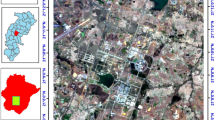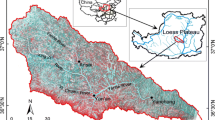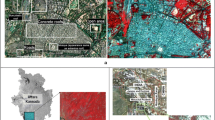Abstract
Tropical coastal wetlands form complex and dynamic ecosystems based on a mixture of vegetation, soil, and water components. Optical remotely sensed data have often been used to characterize and monitor these ecosystems, which are among the environments most threatened by climate change and anthropogenic activity worldwide. The present study sought to evaluate the spectral response of Landsat-5 Thematic Mapper (TM) images for the interpretation of different wetlands and associated environments at the mouth of the Amazon River, including mangroves, saltmarshes, beaches, and dunes, as well as secondary vegetation, water with different levels of sediment suspension, and human occupation. A Spectral Angle Mapper (SAM) classifier was applied to the analysis of Landsat-5 TMsatellite imagery to evaluate the potential for the mapping of these coastal wetland land cover classes. The characterization and comparison of the different spectral classes were obtained through the collection of at least 20 polygonal samples (5 × 5 pixels) for each class, with a total of 4,544 points. Spectral separability indices for each pair of classes were based on an Analysis of Variance, with Tukey post-test. The results indicated that most land cover classes could be separated spectrally with Landsat-5 TM. The overall accuracy and Kappa indices for the results of the classification were 86.1 and 0.84 %, respectively. The results of this spectral analysis demonstrated the potential of the SAM classifier for the classification of the different tropical wetlands in a typical Amazon coastal setting from optical remotely sensed data.




Similar content being viewed by others
References
Adam E, Mutanga O, Rugege D (2010) Multispectral and hyperspectral remote sensing for identification and mapping of wetland vegetation: a review. Wetlands Ecol Manage 18:281–296
Adams JB, Sabol DE, Kapos V, Almeida Filho R, Roberts DA, Smith MO, Gillespie AR (1995) Classification of multispectral images based on fractions of endmembers: Applications to land-cover change in the Brazilian Amazon. Remote Sens Environ 52:137–154
Alongi DM (2002) Present state and future of the world’s mangrove forests. Environ Conserv 29:331–349
Amaral DD (2007) Campos e Florestas das Bacias dos Rios Atuá e Anajás, Ilha do Marajó, Pará. Belém, Editora MPEG
Andrade MMN, Szlafsztein CF, Souza-Filho PWM, Araújo AR, Gomes MKT (2010) A socioeconomic and natural vulnerability index for oil spills in an Amazonian harbor: a case study using GIS and remote sensing. J Environ Manage 91:1972–1980
Artaxo P, Gatti LV, Leal AMC, Longo KM, Freitas SRd, Lara LL, Pauliquevis TM, Procópio AS, Rizzo LV (2005) Química atmosférica na Amazônia: a floresta e as emissões de queimadas controlando a composição da atmosfera amazônica. Acta Amazonica 35:185–196
Bezerra MO, Medeiros C, Krelling APM, Rosário RP, Rollnic M (2011) Physical oceanographic behavior at the Guama/Acara-moju and the Paracauari river mouths, Amazon Coast (Brazil). Journal of Coastal Research SI 64:1448–1452
Chen Z, Curran PJ, Hansom JD (1992) Derivate reflectance spectroscopy to estimate suspended sediment concentration. Remote Sens Environ 40:67–77
Congalton RG (1991) A review of assessing the accuracy of classifications of remotely sensed data. Remote Sens Environ 37:35–46
Congalton RG, Green K (2009) Assessing the accuracy of remote sensed data: principle and pratices, 2nd edn. CRC Press, Boca Raton, p 183
Crósta AP, Sabine C, Taranik JV (1998) Hydrothermal alteration mapping at Bodie, California, using AVIRIS hyperspectral data. Remote Sens Environ 65:309–319
Dawelbait MAA, Morari F (2011) LANDSAT, spectral mixture analysis and change vector analysis to monitor land cover degradation in a Savanna Region in Sudan (1987–1999–2008). Intern J Water Res Arid Environ 1:366–377
Dias MAFS, Rutledge S, Kabat P, Silva Dias PL, Nobre C, Fisch G, Dolman AJ, Zipser E, Garstang M, Manzi AO, Fuentes JD, Rocha HR, Marengo J, Plana-Fattori A, Sá LDA, Alvalá RCS, Andreae MO, Artaxo P, Gielow R, Gatti L (2002) Cloud and rain processes in a biosphere-atmosphere interaction context in the Amazon Region. J Geophys Res 107: 39–1 – 39–17
Donato DC, Kauffman JB, Murdiyarso D, Kurnianto S, Stidham M, Kanninen M (2011) Mangroves among the most carbon-rich forests in the tropics. Nat Geosci 4:293–297
Duke NC, Meynecke JO, Dittmann S, Ellison AM, Anger K, Berger U, Cannicci S, Diele K, Ewel KC, Field CD, Koedam N, Lee SY, Marchand C, Nordhaus I, Dahdouh-Guebas F (2007) A world without Mangroves? Science 317:41–42
Ellison JC (1999) Impacts of sediment burial on Mangroves. Mar Pollut Bull 37:420–426
ENVI. 2008. ITT Visual Information Solutions. ENVI Help. Versão 4.5. RSI: Boulder
França CF, Souza-Filho PWM (2006) Compartimentação morfológica da margem leste da ilha de marajó: zona costeira dos municípios de soure e salvaterra—Estado do Pará. Revista Brasileira de Geomorfologia 7:33–42
França CF, Souza-Filho PWM, El-Robrini M (2007) Análise faciológica e estratigráfica da planície costeira de Soure (margem leste da ilha de Marajó-PA), no trecho compreendido entre o canal do Cajuúna e o estuário Paracauari. Acta Amazonica 37:261–268
Fromard F, Vega C, Proisy C (2004) Half a century of dynamic coastal change affecting mangrove shorelines of French Guiana. A case study based on remote sensing data analyses and field surveys. Mar Geol 208:265–280
Gebbinck MSK (1998) Decomposition of Mixed Pixels in Remote Sensing Images to Improve the Area Estimation of Agricultural Fields. Ph.D. Thesis, Katholieke Universiteit Nijmegen
Gilman EL, Ellison J, Duke NC, Field C (2008) Threats to mangroves from climate change and adaptation options: a review. Aquat Bot 89:237–250
Giri C, Pengra B, Zhu Z, Singh A, Tieszen L (2007) Monitoring mangrove forest dynamics of the sundarbans in Bangladesh and India using multi-temporal satellite data from 1973–2000. Esturine, Coast Shelf Sci 73:91–100
Giri C, Zhu Z, Tieszen LL, Singh A, Gillette S, Kelmelis JA (2008) Mangrove forest distributions and dynamics (1975–2005) of the tsunami-affected region of Asia. J Biogeogr 35:519–528
Giri C, Ochieng E, Tieszen LL, Zhu Z, Singh A, Loveland T, Masek J, Duke N (2011) Status and distribution of mangrove forests of the world using earth observation satellite data. Glob Ecol Biogeogr 20:154–159
Green EP, Clark CD, Mumby PJ, Edwards AJ, Ellis AC (1998) Remote sensing techniques for mangrove mapping. Int J Remote Sens 19:935–956
Guimarães AS, Travassos P, Souza-Filho PWM, Gonçalves FD, Costa F (2010) Impact of aquaculture on mangrove areas in the northern Pernambuco Coast (Brazil) using remote sensing and geographic information system. Aquac Res 41:828–838
Heumann BW (2011) Satellite remote sensing of mangrove forests: recent advances and future opportunities. Prog Phys Geogr 35:87–108
Hirano AM, Madden M, Welch R (2003) Hyperspectral image data for mapping wetland vegetation. Wetlands 23:436–448
Howland WG (1980) Multispectral aerial photography for wetland vegetation mapping. Photogramm Eng Remote Sens 46:87–99
Huete AR, Jackson RD, Post DF (1985) Spectral response of a plant canopy with different soil backgrounds. Remote Sens Environ 17:37–53
Jensen JR, Lin H, Yang X, Ramsey EW, DAvis BA, Thoemke CW (1991) The measurement of mangrove characteristics in southwest Florida using SPOT multispectral data, Geocarto Internatinal, 2:13–21
Kathiresan K, Rajendran N (2005) Coastal mangrove forests mitigated tsunami. Estuar Coast Shelf Sci 65:601–606
Kovacs JM, WangJ Flores-Verdugo F (2005) Mapping mangrove leaf area index at the species level using IKONOS and LAI-2000 sensors for the Agua Brava Lagoon, Mexican Pacific. Estuar Coast Shelf Sci 62:377–384
Kovacs J, Vandenberg C, Flores-Verdugo F (2006) Assessing fine beam RADARSAT-1 backscatter from a white mangrove (Laguncularia racemosa (Gaertner)) canopy. Wetl Ecol Manage 14:401–408
Krause G, Bock M, Weiers S, Braun G (2004) Mapping land-cover and mangrove structures with remote sensing techniques: a contribution to a synoptic GIS in support of coastal management in North Brazil. Environ Manag 34:429–440
Kruse FA, Lefkoff AB, Boardman JW, Heidebrecht KB, Shapiro AT, Barloon PJ, Goetz AFH (1993) The spectral image processing system (SIPS)—interactive visualization and analysis of imaging spectrometer data. Remote Sens Environ 44:145–163
Kuenzer C, Bluemel A, Gebhardt S, Quoc TV, Dech S (2011) Remote sensing of mangrove ecosystems: a review. Remote Sens 3:878–928
Lara R, Cohen MCL (2006) Sediment porewater salinity, inundation frequency and mangrove vegetation height in Bragança, North Brazil: an ecohydrology-based empirical model. Wetlands Ecol Manage 14:349–358
Liu K, Li X, Shi X, Wang S (2008) Monitoring mangrove forest changes using remote sensing and GIS data with decision-tree learning. Wetlands 28:336–346
MacAlister C, Mahaxay M (2009) Mapping wetlands in the Lower Mekong Basin for wetland resource and conservation management using Landsat ETM images and field survey data. J Environ Manage 90:2130–2137
Macieira RM, Giarrizzo T, Gasparini JL, Sazima I (2012) Geographic expansion of the invasive mud sleeper Butis koilomatodon (Perciformes: Eleotridae) in the western Atlantic Ocean. J Fish Biol 81:308–313
MacKay H, Finlayson CM, Fernández-Prieto D, Davidson N, Pritchard D, Rebelo LM (2009) The role of Earth Observation (EO) technologies in supporting implementation of the Ramsar Convention on Wetlands. J Environ Manage 90:2234–2242
Magris RA, Barreto R (2010) Mapping and assessment of protection of mangrove habitats in Brazil. Pan-Am J Aquat Sci 5:546–556
Mas JF (2004) Mapping land use/cover in a tropical coastal area using satellite sensor data, GIS and artificial neural networks. Estuar Coast Shelf Sci 59:219–230
Menezes MPM, Berger U, Mehlig U (2008) Mangrove vegetation in Amazonia: a review of studies from the coast of Pará and Maranhão States, north Brazil. Acta Amazonica 38:403–420
Menezes MOB, Macedo SRP, Corrêa SC, Farage ER (2009) Efeitos da Expansão Urbana nas Ilhas do Baixo Estuário do Amazonas: O Caso de Soure, Arquipélago do Marajó. Revista da Gestão Costeira Integrada 9:113–126
Moraes BC, Costa JMN, Costa ACL, Costa MH (2005) Variação espacial e temporal da precipitação no estado do Pará. Acta Amaz 35:207–214
Nascimento Jr., WR, Souza-Filho PWM, Proisy C, Lucas RM, Rosenqvist A (2012) Mapping changes in the largest continuous Amazonian mangrove belt using object-based classification of multisensor satellite imagery. Estuarine, Coastal and Shelf Science. In press. doi: 10.1016/j.ecss.2012.10.005
Novo EMLM, Shimabukuro YE (1997) Identification and mapping of the Amazon habitats using a mixing model. Int J Remote Sens 18:663–670
Ozesmi SL, Bauer ME (2002) Satellite remote sensing of wetlands. Wetl Ecol Manag 10:381–402
Petropoulos GP, Vadrevu KP, Xanthopoulos G, Karantounias G, Scholze M (2010) A comparison of spectral angle mapper and artificial neural network classifiers combined with landsat TM imagery analysis for obtaining burnt area mapping. Sensors 10:1967–1985
Ponzoni FJ, Shimabukuro YE, Bryan R (2012) Sensoriamento Remoto no Estudo da Vegetação. São Paulo, Oficina do Texto, p 164p
Price JC (1992) Variability of high resolution crop reflectance spectra. Int J Remote Sens 14:2593–2610
Price KP, Guo X, Stiles JM (2002) Optimal Landsat TM band combinations and vegetation indices for discrimination of six grassland types in eastern Kansas. Int J Remote Sens 23:5031–5042
Proisy C, Mougin E, Fromard F, Karam MA (2000) Interpretation of polarimetric radar signatures of Mangrove forests. Remote Sens Environ 71:56–66
Proisy C, Mougin E, Fromard F, Trichon V, Karam MA (2002) On the influence of canopy structure on the radar backscattering of mangrove forests. Int J Remote Sens 23:4197–4210
Proisy C, Couteron P, Fromard F (2007) Predicting and mapping mangrove biomass from canopy grain analysis using Fourier-based textural ordination of IKONOS images. Remote Sens Environ 109:379–392
Proisy C, Gratiot N, Anthony EJ, Gardel A, Fromard F, Heuret P (2009) Mud bank colonization by opportunistic mangroves: a case study from French Guiana using lidar data. Cont Shelf Res 29:632–641
RADAMBRASIL 1974. Folha SA-22. Belém: geologia, geomorfologia, solos, vegetação e uso potencial de terra. DNPM:Brasília
Rajitha K, Mukherjee CK, Vinu Chandran R (2007) Applications of remote sensing and GIS for sustainable management of shrimp culture in India. Aquac Eng 36:1–17
Rakotomavo A, Fromard F (2010) Dynamics of mangrove forests in the Mangoky River delta, Madagascar, under the influence of natural and human factors. For Ecol Manage 259:1161–1169
Ramsey EW, Jensen JR (1996) Remote sensing of mangrove wetlands: relating canopy spectra to site-specific data. Photogramm Eng Remote Sens 62:939–948
Rebelo LM, Finlayson CM, Nagabhatla N (2009) Remote sensing and GIS for wetland inventory, mapping and change analysis. J Environ Manage 90:2144–2153
Richards JA (1999) Remote sensing digital image analysis. Springer-Verlag, Berlin, p 240
Rodrigues S, Souza-Filho PWM (2011) Use of multi-sensor data to identify and map Tropical Coastal Wetlands in the Amazon of Northern Brazil. Wetlands 31:11–23
Rosenqvist A, Milne A, Lucas R, Imhoff M, Dobson C (2003) A review of remote sensing technology in support of the Kyoto Protocol. Environ Sci Policy 6:441–455
Rosenqvist A, Finlayson CM, Lowry J, Taylor D (2007) The potential of long-wavelength satellite-borne radar to support implementation of the Ramsar Wetlands Convention. Aquat Conserv Marine Freshw Ecosyst 17:229–244
Rosso PH, Ustin SL, Hastings A (2005) Mapping marshland vegetation of San Francisco Bay, California, using hyperspectral data. Int J Remote Sens 26:5169–5191
Rubin JA, Gordon C, Amatekpor JK (1999) Causes and consequences of Mangrove deforestation in the volta estuary, Ghana: some recommendations for ecosystem rehabilitation. Mar Pollut Bull 37:441–449
Satyanarayana B, Mohamad KA, Idris IF, Husain ML, Dahdouh-Guebas F (2011) Assessment of mangrove vegetation based on remote sensing and ground-truth measurements at Tumpat, Kelantan Delta, East Coast of Peninsular Malaysia. Int J Remote Sens 32:1635–1650
Seher J, Tueller P (1973) Color aerial photography for marshland. Photogramm Eng 39:489–499
Shearman PL (2010) Recent change in the extent of Mangroves in the Northern Gulf of Papua, Papua New Guinea. Ambio 39:181–189
Shima LJ, Anderson RR, Carter VP (1976) The use of aerial color infrared photography in mapping the vegetation of a freshwater marsh. Chesap Sci 17:74–85
Sohn Y, Qi J (2005) Mapping detailed ciotic Communities in the upper San Pedro Valley of Southeastern Arizona using Landsat 7 ETM_ Data and supervised spectral angle classifier. Photogramm Eng Remote Sens 71:709–718
Souza CM Jr, Roberts DA, Cochrane MA (2005) Combining spectral and spatial information to map canopy damage from selective logging and forest fires. Remote Sens Environ 98:329–343
Souza-Filho PWM, Paradella WR (2002) Recognition of the main geobotanical features in the Bragança mangrove coast (Brazilian Amazon Region) from Landsat TM e RADARSAT-1 data. Wetl Ecol Manag 10:123–132
Souza-Filho PWM, Paradella WR (2003) Use of synthetic aperture radar for recognition of Coastal Geomorphological Features, land-use assessment and shoreline changes in Bragança coast, Pará, Northern Brazil. Ann Braz Acad Sci 75:341–356
Souza-Filho PWM, Martins ESF, Costa FR (2006) Using mangrove as a geological indicator of coastal changes in the Bragançamacrotidal flat, Brazilian Amazon: a remote sensing data approach. Ocean Coast Manag 49:462–475
Souza-Filho PWM, Prost MTRC, Miranda FP, Sales MEC, Borges HV, Costa FR, Almeida EF, Nascimento Junior WR (2009) Environmental sensitivity index (ESI) mapping of oil spill in the amazon coastal zone: the PIATAM Mar project. Revista Brasileira de Geofísica 27:07–22
Souza-Filho PWM, Paradella WR, Rodrigues SWP, Costa FR, Mura JC, Gonçalves FD (2011) Discrimination of coastal wetland environments in the Amazon region based on multi-polarized L-band airborne Synthetic Aperture Radar imagery. Estuar Coast Shelf Sci 95:88–98
Spalding M, Kainuma M, Collins L (2010) World atlas of Mangroves, 2nd edn. Earthscan, London 336p
Stoner ER, Baumgardner MF (1981) Characteristic variations in reflectance of soil surface soils. Soil Sci Soc Am J 45:1161–1165
Thu PM, Populus J (2007) Status and changes of mangrove forest in Mekong delta: case study in Tra Vinh, Vietnam. Estuar Coast Shelf Sci 71:98–109
Tiner RW (1999) Wetland indicators: a guide to wetland identification, classification and mapping. CRC Press, Boca Raton
Tuxen K, Schile L, Stralberg D, Siegel S, Parker T, Vasey M, Callaway J, Kelly M (2011) Mapping changes in tidal wetland vegetation composition and pattern across a salinity gradient using high spatial resolution imagery. Wetl Ecol Manag 19:141–157
USGS (2007) Revised Landsat 5 Thematic mapper radiometric calibration. http://landsat.usgs.gov/documents/L5TM_postcal_v11.pdf. Accessed 07 Apr 2009
Valiela I, Bowen JL, York JK (2001) Mangrove forests: one of the world’s threatened major tropical environments. Bioscience 51:807–815
Verheyden A, Dahdouh-Guebas F, Thomaes K, De Genst W, Hettiarachchi S, Koedam N (2002) High-resolution vegetation data for mangrove research as obtained from aerial photography. Environ Dev Sustain 4:113–133
Xie Y, Sha Z, Yu M (2008) Remote sensing imagery in vegetation mapping: a review. J Plant Ecol 1:9–23
Acknowledgments
The present study was part of our Marine Science and Universal projects, supported by CAPES and CNPq (Brazil), respectively. We would also like to acknowledge the Amazon Protection System (SIPAM) and Amazon Institute of People and the Environment (Imazon) for supporting research in the Amazon, and the Brazilian Institute for Space Research (INPE) and the Global Land Cover Facility Project for supplying us with images. Finally, we would also like to thank the reviewers for their valuable contribution to the final version of this manuscript. The third author is grateful to CNPq for a research Grant.
Funding
This research was supported by Oceanographic Project to study Brazilian mangroves. It was approved under the Notice of Marine Sciences from CAPES, for the period 2010–2014.
Author information
Authors and Affiliations
Corresponding author
Rights and permissions
About this article
Cite this article
Cardoso, G.F., Souza, C. & Souza-Filho, P.W.M. Using spectral analysis of Landsat-5 TM images to map coastal wetlands in the Amazon River mouth, Brazil. Wetlands Ecol Manage 22, 79–92 (2014). https://doi.org/10.1007/s11273-013-9324-4
Received:
Accepted:
Published:
Issue Date:
DOI: https://doi.org/10.1007/s11273-013-9324-4




